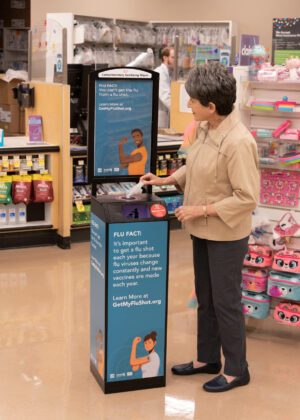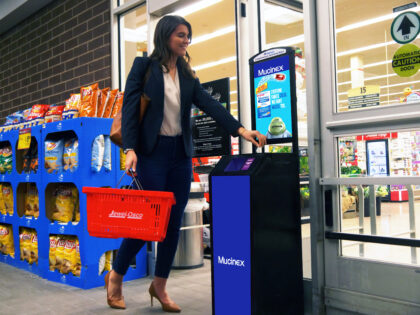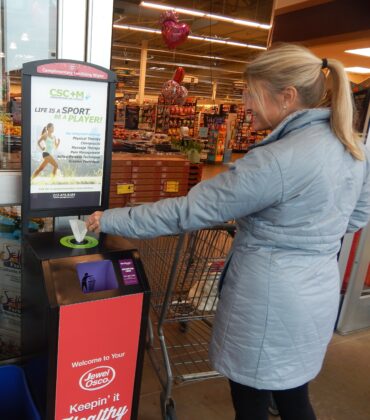Over the past few years, pharmaceutical companies have implemented massive advertising campaigns to encourage the public to get vaccinated against COVID-19.
Some of these advertising strategies were more successful than others, so let’s look at the 4 most effective vaccine marketing strategies that can apply to vaccines against COVID-19, the flu, HPV, and other prominent diseases.
Wellness Boards
Wellness billboards offer shoppers sanitizing wipes from a dispenser located below a prominently featured advertisement. These billboards are amazing at engaging with large consumer groups and can be placed at supermarket and drug store storefronts, malls, and even pharmacy wait areas.
Terraboost is an innovator in advertising through wellness billboards and has partnerships with pharmacies like CVS and Walgreens. Pharmacy wait areas are an ideal advertising location for all healthcare marketing because they provide an ideal contextual setting that helps consumers connect with your brand. However, wait areas are hyper-relevant for vaccine promotions because they are located right next to where vaccinations can take place.
If you’re looking for some inspiration, here are two examples of how pharmaceutical companies promoted vaccinations for the flu and COVID-19 in pharmacy wait areas.
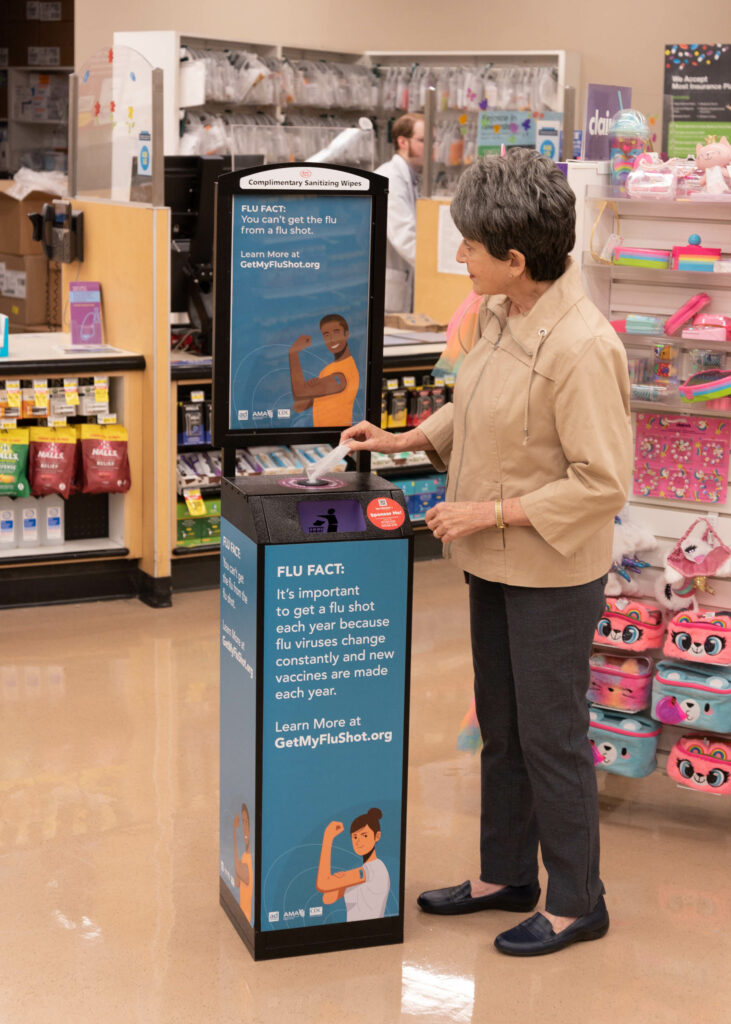
Wellness billboards are much more effective for healthcare advertising than other out-of-home mediums like billboards on highways or busy city streets. When consumers are shopping, they are relaxed and engaging with their surroundings, making them open to promotional material. In addition, independent studies have shown that 80% of shoppers take a wipe from Terraboost wellness billboards and that 50% take a coupon or brochure to learn more.
Successful vaccine promotions target consumer groups at a high frequency to slowly eliminate their vaccine hesitancy. Since sanitizing billboards can be placed in high-trafficked locations that consumers will go to multiple times a week, this advertising medium makes it easy to influence target audiences.
Retargeting With Digital Ads
The most advanced marketing strategies utilize an omnichannel approach to reach audiences across multiple touchpoints and boost conversion rates. One of the most common ways to synergize your physical advertising with your digital material is through retargeting a widely-used pharmaceutical advertising strategy.
Retargeting uses anonymized mobile location data to connect with the devices of shoppers who engage with in-store advertising. This advertising tool will then display online ads on the consumer’s mobile device when they use a search engine or other online platforms. Retargeting is also referred to as remarketing because it delivers advertisements to a target audience that has already been exposed to your ads. Reaching consumers multiple times is a proven strategy to increase awareness and customer conversion. These tactics are a part of effective HCP marketing.
Let’s say that a consumer takes a wipe from a Terraboost sanitizing kiosk in Walgreens. The next time that shopper visits a website, they could see a digital banner ad like the one seen below.
Since this is a newer form of advertising, there aren’t many regulatory hurdles to jump through. This is why many pharmaceutical companies and vaccine distributors favor in-store advertising and retargeting since they aren’t severely limited by the massive amounts of regulations seen in cable television ads or online video marketing.
Influencer Marketing
Marketing experts have seen the rise of celebrities and influencers online and have spent huge portions of their advertising budgets to recruit them as brand ambassadors. Last year, we saw massive growth in the influencer advertising market as it grew to a $16.4B value.
Influencer marketing is an inherently expensive endeavor since you are recruiting celebrities with an established worth and large fan base, a technique often utilized by many pharma ad agencies. When done correctly, these campaigns can boost vaccination rates among the influencer’s followers and fans who place trust in them.
While this advertising method can be successful, it has plenty of potential to backfire. Celebrities and influencers are often involved in controversy and large portions of the population can dislike them, whether that’s for legitimate or illegitimate reasons.
If you are looking for an example of how influencer marketing can backfire, here’s the latest Pfizer advertisement featuring John Legend to promote COVID-19 booster shots:
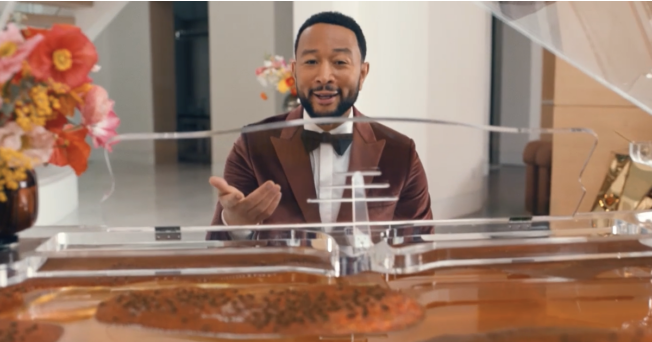
John Legend has a huge following and is a well-known songwriter, so Pfizer must have spent a significant amount of money hiring him for their promotion. However, did the public resonate with the video marketing effort? Well, just take a look at some of the overwhelmingly sarcastic comments…
When it comes to making important medical decisions, like getting the vaccine, consumers don’t appreciate pandering from the celebrity class. These ads often come across as disingenuous and tone-deaf. Instead, people prefer being treated like educated adults and respect ads that use medical experts and doctors to make the case for vaccinations.
TV Commercials
TV commercials have traditionally been relied on to boost general vaccine awareness. These commercials can target specific geographic regions or be implemented nationwide.
NYC’s public health department released a convincing cable TV ad that targeted inner-city communities and showcased both the downsides of getting the flu and the security that came with getting vaccinated:
Though TV commercials can increase public awareness and vaccine acceptance, many marketing experts have turned away from this medium due to its downsides. It can be difficult to track the correlation between your TV commercial and vaccination rates since many consumers either go on their phones or walk away from the screen during ad breaks.
Additionally, cable television ad space can be extremely costly and not return significant levels of engagement. A regional television ad spot that only airs for a few weeks can cost between $1,500-$30,000, but a multi-month nationwide commercial can cost up to $10M+.
Marketing experts have realized that they can reach similar levels of engagement at a fraction of the cost through in-store advertising. For example, Terraboost’s 120,000+ wellness billboards deliver a stunning 8 billion monthly engagements.
Direct Response Marketing
Direct response marketing is a strategy that works to elicit immediate action from a targeted audience. Unlike other advertising mediums mentioned, direct response marketing doesn’t primarily seek to boost vaccine awareness or reduce vaccine hesitancy but reaches consumers who are most likely to get the latest shot.
A great example of direct response marketing took place during the COVID-19 pandemic in which vaccine distributors and healthcare providers reached out to the public based on flu vaccination records.
When people get a flu shot, they often provide their doctor, pharmacy, or medical clinic with their personal information and their preferred method of communication, such as email, text, or phone call. This allowed COVID-19 vaccine distributors to reach an audience that trusts vaccines and message them through communication channels they respond to. In doing so, this direct response marketing effort was very successful in eliciting an almost immediate vaccine appointment from those they targeted. To learn more about such tactics, read about the ways to improve HCP engagement.
Boosting vaccination rates and educating the public through engaging material can be difficult. If you’re looking for some key industry insights, get in touch with a Terraboost agent today who can also provide a free personalized quote.
Advertising in pharmacy wait areas with sanitizing billboards is the ideal way to connect with health-conscious consumers and drive up vaccination rates. With Terraboost, your vaccination promotions could be featured on our network of wellness kiosks that reach 130M people daily with up to 80% engagement.

